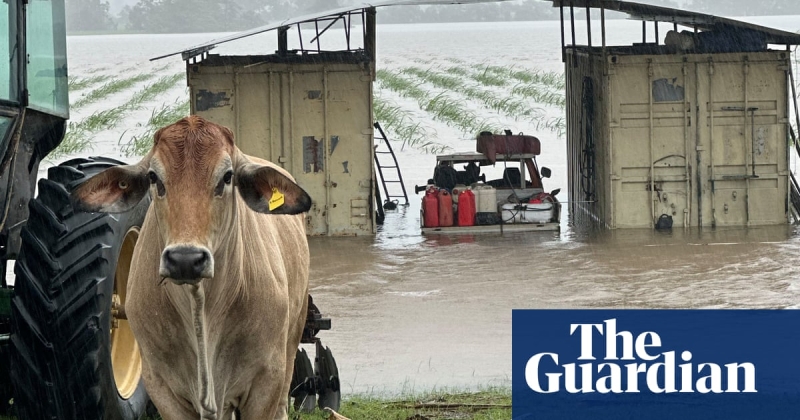As waters rise in this once-in-a-generation flood, the trapped residents of rural Ingham fear for their safety, livelihoods and emotional state
Georgina Bosworth is sitting on the deck of her north Queensland farmhouse on Monday morning enjoying a hot cup of coffee – something she describes as a “very precious commodity right now”. “Hang on a second,” she says into the phone and calls out to her husband.
“Donal! Someone’s in a boat going over the top of our cane paddock.”
But for a patch of grass around their house on which their cattle and horses shiver and nibble, the whole Bosworth farm at Blackrock, a few kilometres south of the north Queensland rural town of Ingham, is under water.
Somehow Bosworth sounds relaxed and composed – despite admitting she has never seen anything like what she is seeing right now.
“We’ve been here since the late 1990s, so we were here for Larry and Yasi and all the big floods since then,” she says, rattling off the names of category 4 and 5 cyclones like slightly challenging relatives. “And we’ve got the most water we’ve ever had in our time here.”
For many of the 4,500 or so people in the sugar cane town about 100km north of Townsville, boat has suddenly become the only means of transport.
Days of torrential rain – including more than 1 metre that fell during a 48-hour period in parts of the tropical north – have submerged fields and inundated the town, forcing evacuations and sweeping away a bridge on the Bruce Highway that connects it to Townsville.
“It’s gone,” Bosworth says of the vital Ollera Creek Bridge. “It’s basically been water-blasted out from underneath.”
Not everyone on a boat around Ingham will be idly punting around. Some are fleeing for higher ground as their houses go under. A 63-year-old woman died in Ingham on Sunday when a State Emergency Service rescue boat carrying six people hit a tree and flipped into the flood waters.
Others may need resources. Power was cut on Sunday when the Ingham electricity substation went under water. People are resorting to gas cookers – hence the rarity of a hot cuppa. With no refrigeration in the dank of the tropics, perishable food has already turned.
Another resource in short supply is one that – on first take at least – may seem counterintuitive for the wettest patch of Australia receiving what may prove to be its most substantial inundation in living memory: water. Treated water, that is.
“The water treatment plant in town doesn’t have power either,” Bosworth says. “I saw on socials that maybe there’s five days of water that’s treated available for the district – if we’re conservative.”
The Bosworths have already filled up their bathtub and other containers with water.
Then there are the other reasons people may need to move, the kind of highly specific reasons that don’t spring to mind for the rest of us, safely removed from the flood zone, watching coverage from a distance.
Like, for example, one of Bosworth’s clients who lives nearby. For not only is Bosworth a sugar cane farmer – she is a midwife.
“Her guess date was yesterday,” she says of her client. “And I say ‘guess date’ deliberately, because nobody knows when the baby’s coming.”
Thankfully, as of Monday morning, there were no signs of labour, because Bosworth does not believe it would be possible for her to get to her client’s home by car.
“But that doesn’t mean we can’t get to each other,” she says. “Country people are very resourceful.”
And the people of Ingham and surrounding areas are going to have to draw upon all of that resourcefulness.
Some of the perils they face are immediate and terrifying in nature: a saltwater crocodile was said to have swum through the streets of Ingham.
Others will emerge over the days, weeks and months that are to follow, says the Hinchinbrook Community Support Centre general manager, Linda McClelland.
A “born and bred” Ingham local, McClelland is stuck in Townsville and has no idea when or how she will be able to return home. Which is just as well, really. Though Townsville too is copping a hammering and some of its residents have been warned to abandon their homes, McClelland has access to power and the resources she needs to start coordinating a response.
Which is much more than can be said for those at “ground zero”, she says.
“It’s getting quite critical for those people who don’t have access to generators,” McClelland says. “They’re without power, their phones are going down, communication’s starting to reduce and they’re potentially running out of food.
“The SES have a huge list of people who have requested evacuation … People who thought they might have been OK at home are now changing their minds, because the water’s getting higher and higher.”
Many, she says, have prepared for a typical flood, using “the great flood of 1967” as a yardstick – “but this flood was not typical”.
“Properties that have never been inundated in the past have been inundated,” McClelland says.
The veteran social services worker is concerned about the emotional toll as well the physical threat the flood poses.
“I’m really worried about the mental wellbeing of my community over the next few days,” she says.
Now, many are trapped in their homes, racked with worry about dwindling resources and rising waters. Soon, though, the flood water will recede and they will be faced with thick-mud-covered yards, homes and vehicles, and “the big cleanup will start”.
“There will be the stench of mud as it starts to dry out once the sun comes out,” McClelland says. “It will be incredibly hot and moist, and the footpath will be running with black mud as people start hosing out, and we’ll start seeing belongings littering footpaths.
“That, psychologically, has a big impact on the community.”
And not everyone has dealt with the likes of it before.
Janice Flores and her family moved from the western Queensland outback town of Longreach to Ingham less than a year ago. They are without power or running water and the flood waters are lapping at the edges of her street.
Flores’ partner works out of town in the mines and can’t return home anytime soon, leaving her to care for her two children, aged 13 and three, on her own. Trapped at home, the kids are fluctuating between being bored, frightened and overwhelmed.
Overnight on Sunday the wind picked up and the rain bucketed down.
“It’s really quite scary,” she says. “I think I haven’t been sleeping the last few days very well.
“Emotionally, it’s all a bit overwhelming.”
As she tries to keep the children entertained, salvage food and move belongings higher up, Flores is kicking herself for not being “100% prepared”. Still, she has done more than might have been expected for a new arrival in town.
Flores thought to run and plug the bath while she still had tap water and has been filling buckets and containers with rainwater for days. When her phone battery died and she could not be contacted, a friend brought over a charger that could be connected to her car battery. She has a supply of canned food.
“We should be OK for the next two to three days, hopefully,” Flores says. “I don’t know what happens after that.”





